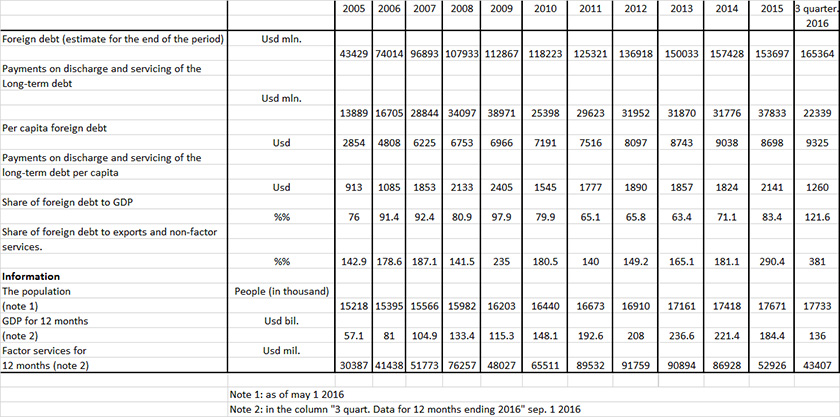We continue to examine risks to the Kazakhstani economy and financial system. In this we are assisted by a very interesting and informative document “Balance of payments and foreign debt of the Kazakh Republic for 9 months of 2016”, published on the website of the National Bank of the KR on Feb. 28th of the current year.
Among other things, there is a table titled “Absolute and comparative parameters of foreign debt”. We chose the numbers from it that seemed interesting to us and created a table. The issue is that it seems that analysts of the regulatory body, against their own will are forced to mask key problems of the economic and financial system of the country.
One of the tools of such masking is the emphasis on the fact that the main indicator, characterizing foreign debt, is not the gross sum of the country’s debt, but rather the sum of debt with the deduction of inter-firm liabilities. There is an economic sense in this approach, since responsibility for inter-firm liabilities, is carried out by daughter companies of foreign corporations- investors, and thus it can be considered an in-house issue.
The problem, however, is in the fact that these foreign corporations-investors are so big and influential that they have a direct access both to political management of their countries, and to Akorda. Also, their daughter companies are the largest taxpayers and employers in the republic, and thus their problems often become public issues. It them, in part who lobby for the devaluation of tenge, in order to increase profitability of their business.
Moreover, country’s main risk – fluctuations of the world prices for key export items, i.e. oil, gas, base and ferrous metals are occurring via that sector of economy. Additionally, foreign corporations-investors will be backed by appropriate states, such as US, EU and member countries, plus China and Russia, if some serious threat to their daughter companies arises, such as that of nationalization or confiscation.
Thus, even though he debts are inter-firm, they will be paid for by the state as a whole. This is why we think that the main indicators of Kazakhstani foreign debt are:
- Gross foreign debt
- Per-capita foreign debt
- Payments on clearing off and servicing of the long-term foreign debt as a whole
- Same as above, but per capita
- Share of foreign debt to GDP
- Share of foreign debt to exports and nonfactor services
We offer this data for the period from 2005 to Sep. 1 2016, in the following table.

We don’t see a reason to comment on these numbers as they speak for themselves. Lets just indicate the state of affairs in this sphere: Kazakhstan and its citizens are in debt head over ears. And we all know how they treat debtors on the market.




